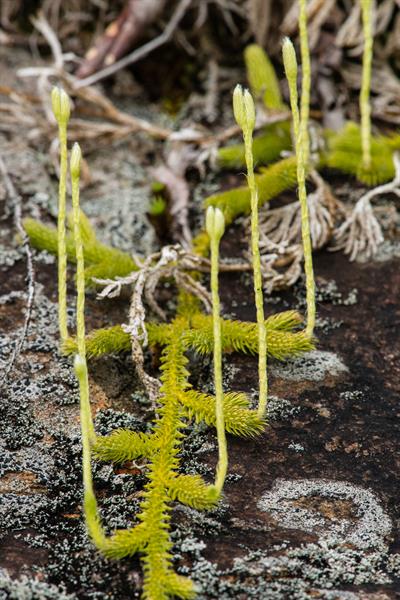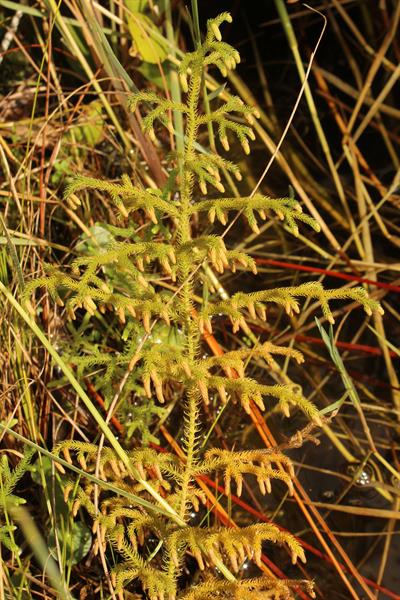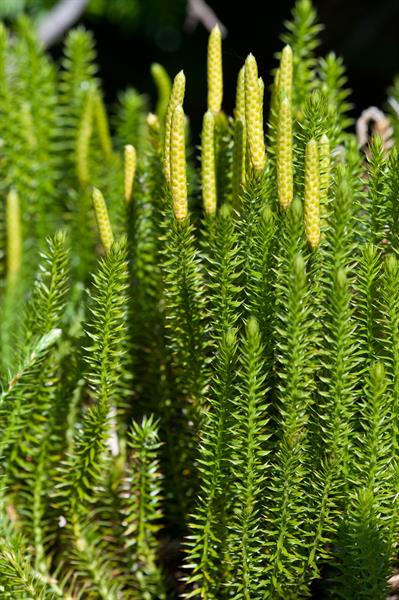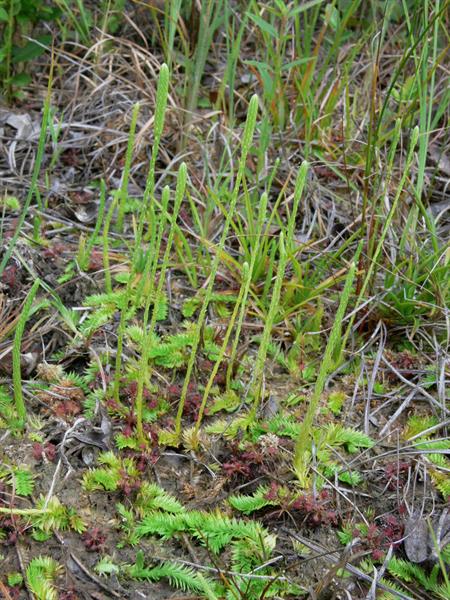
A family of 10-15 genera and about 400 species. Lycopodiaceae + Huperziaceae, along with Selaginellaceae and Isoetaceae, have now been shown to be only distantly related to other extant pteridophytes and seed plants (Pryer et al. 2001). The division of North American Lycopodium into three or more genera has been strongly advocated by Wagner & Beitel (1992), Wagner & Beitel in FNA (1993), Haines (2003a), and nearly all other recent authors. The traditionally broad Lycopodium appears to include a number of natural groups which are strikingly different from one another and have constituted separate lineages for tens to hundreds of millions of years. These natural groups are separable by numerous morphological, developmental, and anatomical characters, karyotype, and inability to hybridize. Wagner & Beitel (1992) divide Lycopodium (sensu latissimo) of our area into six genera in three subfamilies, as follows: Huperzia in Subfamily Huperzioideae, Lycopodium and Diphasiastrum in Subfamily Lycopodioideae, and Lycopodiella, Palhinhaea, and Pseudolycopodiella in Subfamily Lycopodielloideae. Haines (2003a) further divides Lycopodium (sensu lato) into three genera: Dendrolycopodium, Spinulum, and Lycopodium (sensu stricto). The reasoning behind this division is very strong, and it is here followed. Profound differences in anatomy, morphology, reproduction, gametophyte morphology, and karyotype support this separation, in addition to the very great age of these lineages. The chromosome numbers of our genera: Dendrolycopodium (x=34), Diphasiastrum (x=23), Huperzia (x=67, 68), Lycopodiella (x=78), Lycopodium (x=34), Palhinhaea (x=55), Pseudolycopodiella (x=35), and Spinulum (x=34). Øllgaard in Kramer & Green (1990) and Wikström & Kenrick (2000) follow a somewhat broader coarse, recognizing three genera for our species (corresponding to the subfamilies of Wagner & Beitel 1992), and recognizing as sections the genera of Wagner & Beitel (1992). Øllgaard states that the “genera are very distinct, and also the sections within Lycopodiella and Lycopodium seem to represent ancient, independent evolutionary lines”; later, Øllgaard has elevated the sections to generic rank (Øllgaard & Windisch 2014). Wikström & Kenrick (2000, 2001) suggest that the phylogenetic separation of Lycopodium (including Diphasiastrum) and Lycopodiella (including Pseudolycopodiella and Palhinhaea) occurred at least as long ago as the early Jurassic (208 million years before present), and the divergence of Huperzia from Lycopodium and Lycopodiella still longer ago. Based on this deep division between Huperzia and the other genera, some authors additionally advocate the recognition of Huperzia in a separate family, Huperziaceae, an opinion followed here. The generic taxonomy used here follows PPG I (2016).
Ref: Beitel (1979); Chen et al. (2021); Haines (2003a); Kramer & Green (1990); Lellinger (1985); Mickel (1979); Øllgaard (1987); Øllgaard & Windisch (2014); Øllgaard In Kramer & Green (1990); Øllgaard, Kessler, & Smith (2018); PPG I (2016); Pryer et al. (2001); Snyder & Bruce (1986); Testo, Field, & Barrington (2018); Wagner & Beitel (1992); Wagner & Beitel (1993) In Flora of North America Editorial Committee (1993b); Wikström & Kenrick (2000); Wikström & Kenrick (2001). Show full citations.
Hover over a shape, letter, icon, or arrow on the map for definition or see the legend. Data for arrows not developed for genera and families which may have species only occurring outside the flora area.
 © Keith Bradley | Original Image ⭷
© Keith Bradley | Original Image ⭷ © Scott Ward | Palhinhaea cernua | Original Image ⭷
© Scott Ward | Palhinhaea cernua | Original Image ⭷ © Keith Bradley | Spinulum annotinum | Original Image ⭷
© Keith Bradley | Spinulum annotinum | Original Image ⭷ © Bruce A. Sorrie | Pseudolycopodiella caroliniana | Original Image ⭷
© Bruce A. Sorrie | Pseudolycopodiella caroliniana | Original Image ⭷Feedback
See something wrong or missing on about Lycopodiaceae? Let us know here: (Please include your name and email if at all complicated so we can clarify if needed.)
Cite as...